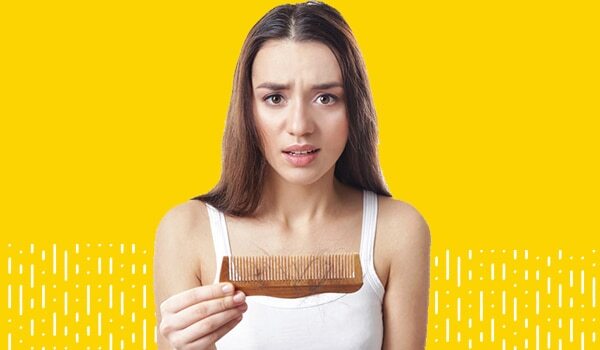- 01 1. Causes of female pattern baldness
- 02 2. Age range that experiences female pattern baldness
- 03 3. How female pattern baldness is diagnosed
- 04 4. Treatments available for female pattern baldness
- 05 5. Expert tips on avoiding female pattern baldness
- 06 6. Did you know?
- 07 7. FAQs about female pattern baldness
Female pattern baldness, also known as androgenic alopecia or female pattern hair loss, is a hair thinning condition seen in women. Caused by a variety of unavoidable conditions, FPHL can be quite troublesome for women as the thinning of hair is very visible and can cause confidence issues. Fortunately, there are ways to treat female pattern baldness, and if done in time, you can even regrow hair. To make the information fool-proof, we spoke to an expert to understand the condition better and here's everything there is to learn about the same. According to Dr. Divya Sharma , "Female pattern baldness is characterized by a reduction in hair density over the crown and frontal scalp with retention of the frontal hairline. Women develop diffuse thinning over the mid-frontal scalp with relative sparing of the anterior hairline." The thinning is mostly seen in three patterns -
01Causes of female pattern baldness

As seen above, there are many reasons that contribute to female pattern baldness. But if we focus on the major contributors to FPHL, we find that genetics plays a major role. Especially if the immediate male or female relatives are suffering from male or female pattern hair loss. Also, the role of the male hormone (androgens) is clearly established in males suffering from male pattern baldness while their role in FPHL is not clearly established. FPHL further involves progressive hair follicle miniaturization and subsequently the conversion of terminal follicles (thick, beard-like) into vellus-like follicles (thin, barely-noticeable hair). These vellus-like follicles have a shortened hair cycle because of a reduction in the anagen phase, which leads to the production of short and fine hair shafts.
02Age range that experiences female pattern baldness

Hair loss may begin at any age after the onset of adrenarche (early stage of sexual maturation - peaks at 20 years) and may precede pubarche (average ages 12-14) and menarche (first menstrual cycle - avg 11. 7 years of age). According to Dr. Sharma, "FPHL may present initially with either episodic or continuous hair shedding, prior to any noticeable reduction in hair volume. Alternatively, some women present with diffuse thinning over the crown, unaware of any increase in hair shedding."
03How female pattern baldness is diagnosed

The diagnosis of female pattern baldness is mainly clinical and in some cases, advanced diagnostic tools like Trichoscopy and Scalp biopsy may also be required. A history and physical examination should aim at detecting signs of hyperandrogenism - such as hirsutism, ovarian abnormalities, menstrual irregularities, acne and infertility. Laboratory test results are rarely evaluated in women who suffer from FPHL with no signs of hyperandrogenism. As such, if you suspect that you are suffering from this condition, seek professional help as soon as possible.
04Treatments available for female pattern baldness

Treatment options available for FPHL can be classified into two categories - topical and systemic drugs:
i) Topical:
A popular solution for hair loss in women, minoxidil is a potassium channel opener and stimulates hair growth by increasing the growth phase of the hair cycle. Minoxidil enhances blood supply around the follicle, but the exact mechanisms are currently unknown. However, there are some facts that you should know about this treatment:
- Minoxidil has been known to show 30-40% improvement after 3 to 6 months of usage.
- Long-term use and the risk of increased hair growth on the face (if applied carelessly) are a few of the adverse effects.
- Patients should also be warned that during the first months of treatment, a transient increase in shedding may occur.
- Treatment side effects are uncommon and include allergic or irritative contact dermatitis, which is more commonly related to the solution vehicle propylene glycol.
ii) Systemic drugs:
Systemic drugs like Androgen blockers may be used in patients with abnormal hormonal profiles. Such patients might need an endocrinologist's opinion as well. However, oral drugs can come with their own set of side effects as well - with issues like fatigue, spotting, irregular periods and tender breasts being a few of the complaints made by patients. Also, certain procedures like platelet-rich plasma therapy (PRP) and microneedling may be more effective in improving hair growth as they work by rejuvenating the hair follicles. Unfortunately for believers in supplements to treat hair issues, the benefit of oral supplementation with amino acids, biotin, zinc, and other micronutrients in hair loss of any origin is still debatable.
05Expert tips on avoiding female pattern baldness

According to Dr. Sharma , "Keeping a tab on nutritional status is very important as FPHL patients have lower iron levels when compared to normal people. You should be physically active and should prefer a healthy, low carbohydrate and high protein diet." Furthermore, an increase in weight, hectic schedules and irregular sleep cycles may all lead to hormonal imbalance. Avoid tight hairstyles as well. A caffeine-based shampoo may be desirable. Green tea extract, ginseng and caffeine-based shampoos may be beneficial. Avoid hair straightening or aggressive chemical procedures if you suspect that you might have or may develop the condition.
06Did you know?

According to Dr. Sharma , "FPHL is very much treatable and adverse impact may be prevented by timely intervention. Wasting time on 'natural' ways to regain hair may make us lose precious time as earlier the treatment is started, better are the results." It is also necessary to address certain myths associated with FPHL. For instance, frequently wearing hats will not cause hair loss, they cannot damage your scalp to this extent. Also, your hair follicles get oxygen from the bloodstream rather than the air, so wearing a scarf won't suffocate your scalp either. There is also the myth that frequent shampooing can cause baldness. While excessive shampoo use can dry out your scalp, it certainly won't lead to hair loss to this degree.
07FAQs about female pattern baldness

Q. Which is the best vitamin for hair loss?
**A. **Supplementing your diet with B-vitamins can help deal with hair loss. To be precise, biotin is the compound that is most associated with hair loss. So, if you are biotin deficient, consuming its supplements can be beneficial for you.
Q. Can scalp massage stimulate hair follicles for faster hair growth?
**A. **Yes, head massage can boost blood circulation on your scalp and thus help with stimulating hair follicles for faster hair growth. Make sure that you are gentle with the head massage and apply minimal pressure with your fingertips, especially while applying a scalp treatment like minoxidil.
Q. Is female pattern baldness common?
**A. **Female pattern baldness can increase with age and can affect less than 50% of women to varying degrees.
Q. Can hair grow back after thinning due to female pattern baldness?
**A. **Yes, hair can grow back after thinning due to FMHL, but it largely depends on the underlying cause of the same. Also, different forms of treatment can have different results for people.





